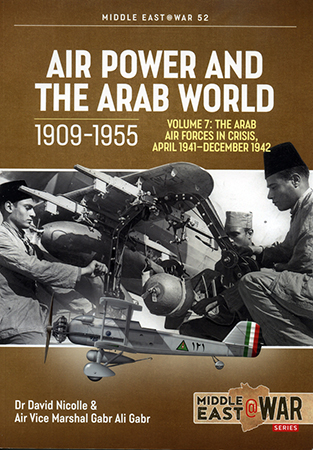
Air Power and the Arab World 1909-1955, Volume 7 Book Review
By David L. Veres
| Date of Review | February 2024 | Title | Air Power and the Arab World 1909-1955, Volume 7 |
|---|---|---|---|
| Author | David C. Nicolle, with Gabr Ali Gabr | Publisher | Helion |
| Published | 2023 | ISBN | 9781804510346 |
| Format | 84 pages, softbound | MSRP (USD) | $29.95 |
Review
Tensions between Arab nationalists and accommodationists erupt in Air Power and the Arab World 1909-1955, Volume 7 – 52nd in Helion’s vast “Middle East@War” range.
Subtitled “The Arab Air Forces in Crisis, April 1941-December 1942”, coverage commences with, arguably, the most pivotal event in Arab lands during WWII: the Anglo-Iraqi War of May 1941.
Allied battlefield reversals emboldened Arab nationalists, who rapidly sought the end of Commonwealth influence – and, ultimately, the expulsion of British military presence.
Iraq especially charted an independent path by sourcing warplane purchases not only from Britain, but from Fascist Italy and the United States, as well.
By 1941, it boasted the region’s most powerful Arab air force. That initially formed the spear tip of Iraqi efforts forcibly to eject Commonwealth forces. And when those attempts failed, enlisted Nazi German and Fascist Italian air assets to the cause.
Text swiftly segues to a chapter on the RIrAF’s reconstruction, and thence to a section on tensions between nationalist and accommodationist factions in Egypt – then literally on the frontline of WWII in North Africa.
Text brims with actions, incidents, anecdotes, and allegations – usually, in cases involving Britons and Jews, negative.
In the event that “Rommel broke through into the Egyptian heartlands”, authors claim, for instance, that Britain heartlessly “envisaged a scorched earth policy in the Delta and parts of the Nile Valley where millions of Egyptian civilians lived. It focused on the destruction of major industries, capital projects, communications and the media.”
But as Carl Sagan once observed, “extraordinary claims require extraordinary evidence”. And authors offer hearsay attestation for their callous contention.
Therein lies the book’s principal flaw: a paucity of independently confirmable, supporting proof.
Only when, amidst dozens of unattributed quotes and claims, authors occasionally or obliquely proffer citations within text can readers glean sources – and avoid sifting through the book’s bibliography list to infer origins.
But even that might not help. Why, for instance, does the name of “respected historian Gerald Butt” fail to appear in book references? And what was the source of his quote?
For that matter, where are Tewfik Aclimandos and his book Revisiting the History of the Egyptian Army, tagged for special mention on page 35, on the same list? And where are G.W. Houghton and his They Flew Through Sand, similarly cited on page 58?
Finally, GCIII/6 had long traded their MS.406 C1 fighters for Dewoitine D.520s when that No.208 Squadron Hurricane was downed. And Britain’s alleged 1942 abandonment of the (important) Siwa Oasis to a 450-strong garrison of Fascist Youth (Giovani Fascisti) [!] supported by obsolete Caproni Ca 310 reconnaissance bombers “or” Ca 309 colonial aircraft – both designs notorious for, at best, mediocre performance in 1942 – frankly beggars belief.
But I nitpick, too. If English-only readers didn’t have the team of David Nicolle and Gabr Ali Gabr, they’d completely lose these histories – warts and all.
And that’s why I can’t wait to read the next installment of Air Power and the Arab World 1909-1955.
Recommended!
My sincere thanks to Casemate for this review sample!







